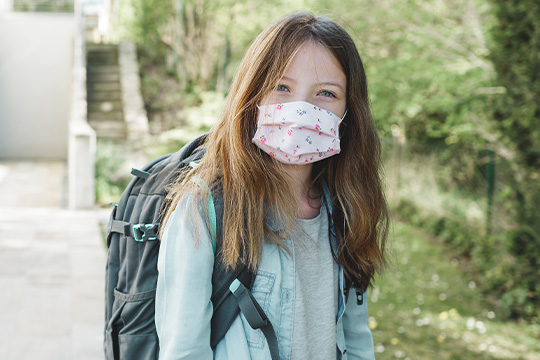School will look much different this fall as Minnesota continues to make careful choices to limit the spread of COVID-19 in our communities. On July 30, 2020, Governor Tim Walz held a press conference outlining the guidance for Minnesota schools this fall: The Safe Learning Plan. This data-driven plan allows schools to begin in one of three models: in-person learning, distance learning or a hybrid model. The Department of Education will work with school districts and health professionals to decide when to shift between models based on the community’s specific needs and situations.
One of the biggest differences between this back to school season and last year’s is the importance of face coverings and masks. Nearly all school-age children, including kids with asthma, can and should wear a mask at school to protect themselves and others.
Even though back to school time is much different this year, we have tips to help parents and kids make the most of the school year.
Tips for a safe and healthy school year
Dr. Gigi Chawla, chief of general pediatrics at Children’s Minnesota, talks about what parents can do to prepare their kids for the school year, whether their school goes back in-person, virtually or in a hybrid model.
“There is a lot that’s under your control,” said Dr. Chawla. “First of all, make sure that your kid has had their physical exam, get their routine childhood vaccines, make sure you get a flu shot, and think about doing a temperature check or a symptom check before your child goes to school. And don’t send your kids to school sick.”
Mask tips for kids

- Kids’ masks should cover their mouth and their nose.
- Do not touch your mask when it is on.
- Only touch the straps or ear loops when putting on or taking off your mask.
- Always wash your hands before and after touching your mask.
- Keep masks clean and off of the floor.
- Remember which side of the mask is the inside and which is the outside.
- Remind kids that their mask is their own and they should not share with their friends.
- If masks are uncomfortable for your child, here are some tips to make masks easier to wear: How to make masks more comfortable for kids.
In-person learning tips
- Teach your child what 6 feet apart looks like.
- Send your child with their personal hand hygiene, like a hand sanitizer, and teach them to use it frequently. Watch our video together to brush up on your hand cleaning skills!
- Children should have their own school supplies and should not share them with classmates.
- Consider other transportation options if your child’s school bus is crowded.
- Complete a wellness check at the start of each day.
- Keep kids home when they are sick, even if their symptoms are mild.
- Stay up-to-date on vaccines like the flu shot. Schedule a well-child check-up.
Distance learning tips
- Try to keep a routine for your children. Have them wake up early enough to engage in online classes: Get ready for the day, out of pajamas, and out of bed, just as they would if they were attending school in-person.
- Create a separate school area where your child can focus on learning.
- Turn off their phone, tablet or television if they are not needed for school.
- Take breaks to be active during the day. Make sure they move around in between online classes, just like when they would have walked from one class to the next one.
- Ask your child’s teacher for help to personalize their education as needed.
- Prioritize mental health and recognize that distance learning is stressful.
Mental health tips
Not only does going back to school affect kids’ mental health, this time is difficult for parents too. Remember to take care of your own mental health, too. Here are some resources for your family:
- Minnesota Department of Health (MDH) mental health crisis line, call: **CRISIS (**274747).
- It’s OK to not be OK: Coping strategies for families.
- COVID-19 and mental health. What parents need to know.
- Coronavirus (COVID-19): Calming anxiety.
- Managing your toddler’s behavior (Video).
Tips for parents
If you see a situation at school that makes you uncomfortable, make sure you speak up and share your concerns.
The decision to have your child attend or not attend school can be complicated. Try to think about your child’s and family’s physical health and safety, the social and emotional impact it could have on your child, the financial impact on your family, and whether your family needs to rely on critical support services that schools provide.
COVID-19
For more information about COVID-19: